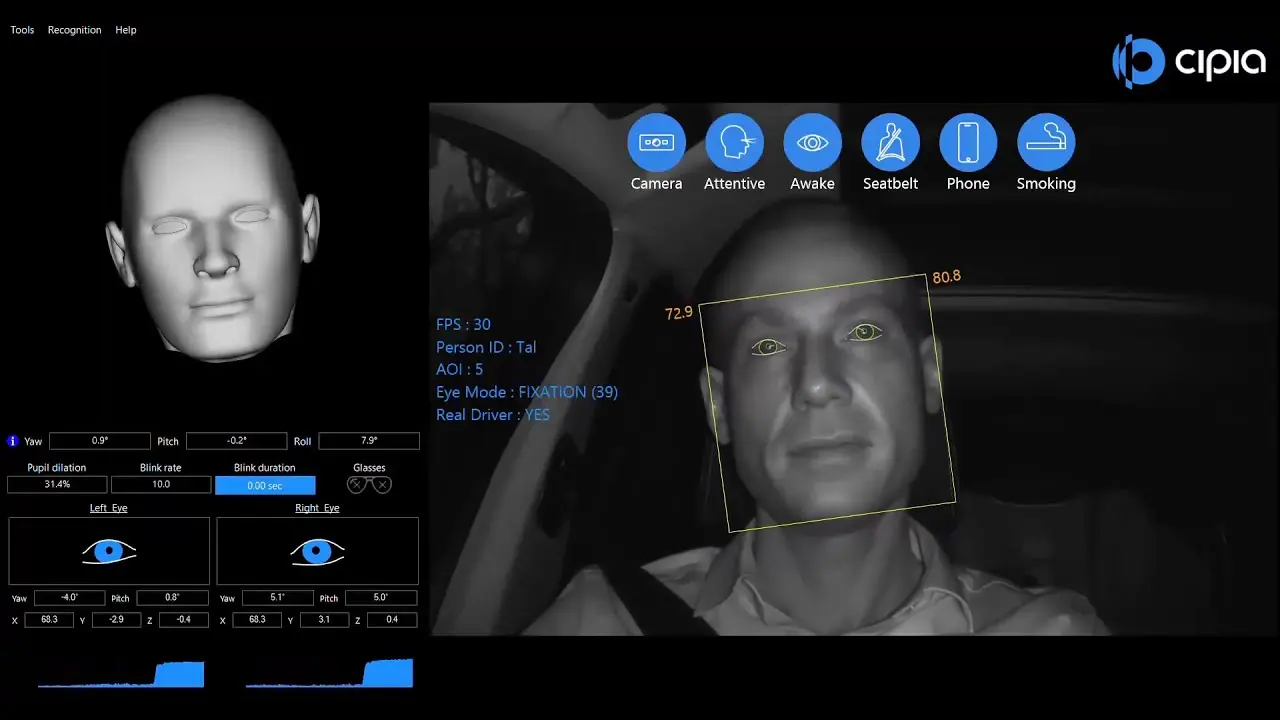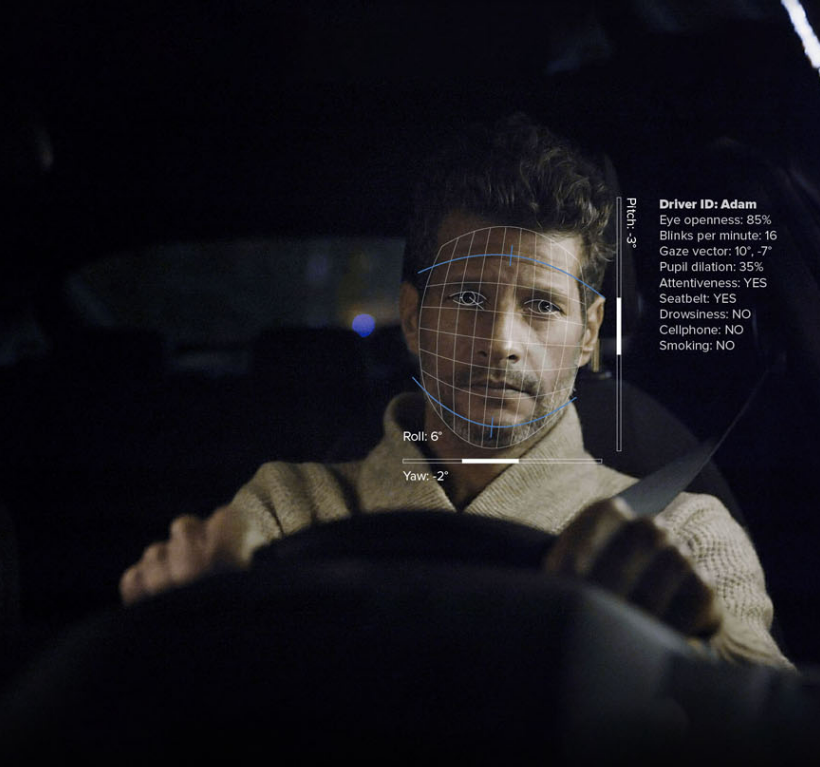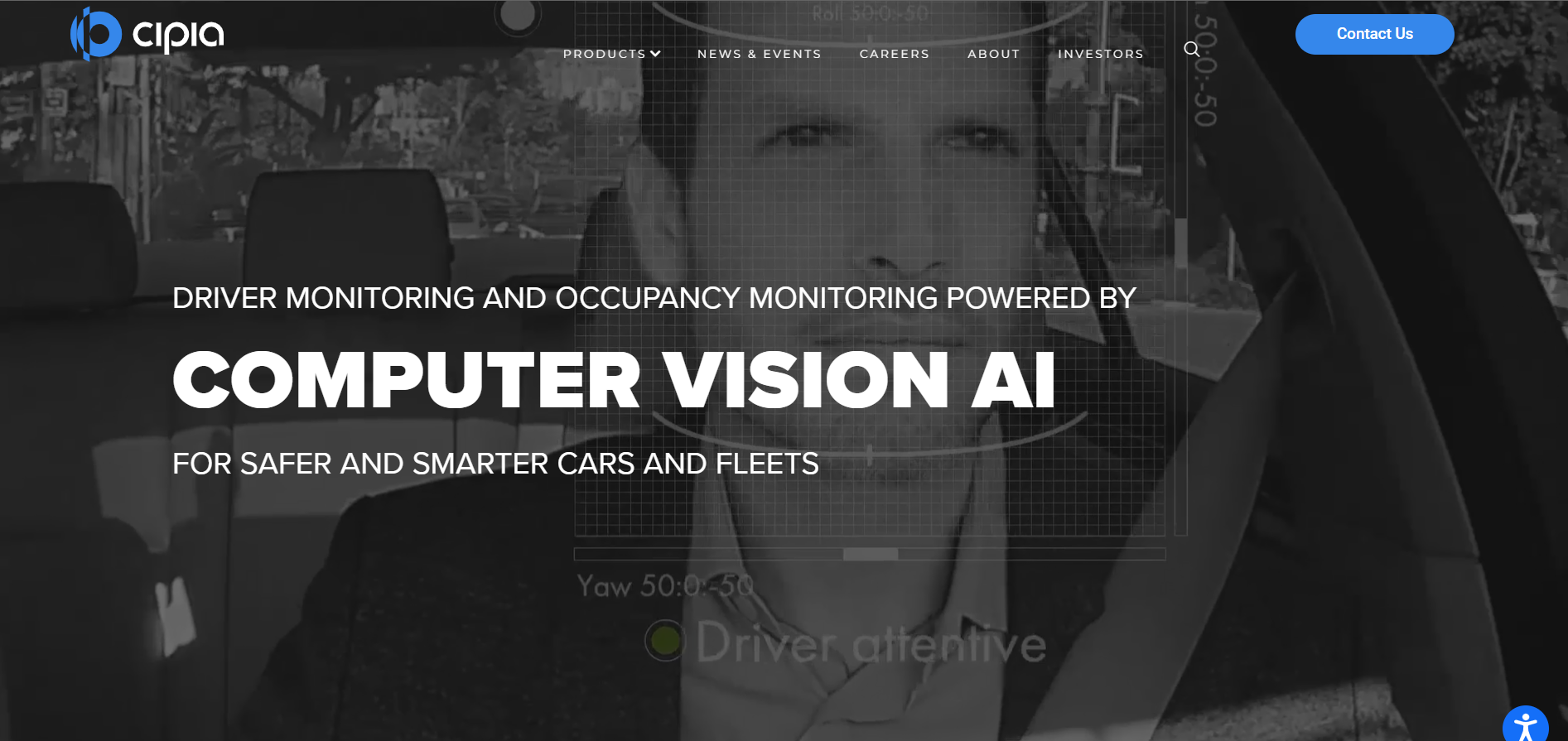Computer Vision Makes Drive Safer with DMS

Driver Monitoring Systems (DMS) is a type of technology that uses various sensors and cameras to monitor the behavior and alertness of the driver while operating a vehicle.
DMS typically uses facial recognition and eye-tracking technology to detect and analyze the driver's facial expressions and eye movements in real-time.
The system can monitor factors such as driver fatigue, distraction, and drowsiness and can alert the driver if it detects any signs of inattention or fatigue. DMS can also be used to ensure compliance with safety regulations and improve vehicle safety.
The development of autonomous driving technology has been an ongoing process for several years. However, implementing DMS technology has become increasingly important due to the growing concern about the safety of autonomous vehicles.
As a result, the industry has invested significant time and money into developing and implementing DMS solutions.

Figure: Driver monitoring system
According to the National Highway Traffic Safety Administration (NHTSA), in 2019, there were over 36,000 fatalities and 2.7 million injuries resulting from motor vehicle accidents in the United States alone.
Additionally, the NHTSA reported that over 90% of these accidents were caused by human error, such as distracted driving, drowsy driving, or impaired driving.
The implementation of DMS technology in autonomous vehicles aims to reduce the number of accidents caused by human error by monitoring the driver's behavior and alerting them if they become distracted or disengaged.
DMS technology uses cameras and advanced algorithms to analyze the driver's eye movements, head position, and other factors to determine if the driver is paying attention and alert them if necessary.
Role of Computer Vision
Computer vision is a critical technology in solving the safety problem in autonomous driving. DMS technology uses cameras and advanced algorithms to monitor the driver's behavior and assess their level of alertness and attention.
By analyzing the driver's eye movements, head position, and other factors, the DMS can determine if the driver is paying attention and alert them if necessary.
Additionally, computer vision technology can detect hazards such as pedestrians, cyclists, and other vehicles and take appropriate action to avoid collisions.
Furthermore, DMS technology can personalize the driving experience based on the driver's preferences and behavior.
Cipia is one example of a company that solves the safety problem in autonomous driving through DMS technology. Cipia's DMS technology uses computer vision and artificial intelligence to analyze the behavior and movements of drivers and passengers in vehicles.
Their DMS technology can monitor the driver's level of alertness and attention, detect hazards, and personalize the driving experience based on their preferences and behavior.
Additionally, their technology can authenticate and identify drivers, ensuring that only authorized persons operate the vehicle.
Cipia's technology is used in various industries, including automotive, ridesharing, and fleet management, and aims to improve road safety and enhance the driving experience for everyone.
About Cipia
Cipia is a technology company that provides advanced driver and occupant monitoring systems solutions. They are based in Israel and were founded in 2017.
Cipia's DMS technology uses cameras and advanced algorithms to monitor the behavior and movements of drivers and passengers in vehicles. Their technology can detect hazards, assess the driver's level of alertness and attention, and personalize the driving experience based on their preferences and behavior.
There are three main features that Cipia mainly emphasize in their solutions for safer driving:
Driver Sense
Driver Sense is a software-based driver monitoring system that detects signs of fatigue and distracted driving in real time. It can also identify specific drivers and monitor their activities and can be pre-installed by manufacturers and Tier 1s in vehicles.
Driver Sense is a driver monitoring solution - that is capable of detecting the following:
- Drowsiness
- Distraction
- Using a seatbelt
- Identification of registered drivers
- When holding a phone
- Smoking
- Putting on a face mask

Figure: Driver Sensing
Cipia-FS10
The Cipia-FS10 video telematics and driver monitoring device is an aftermarket solution for fleets and telematics system providers. It detects driver weariness, distractions, and actions, providing alerts to the driver and cost-saving features to the fleet management system. The device identifies the driver's condition, behaviors, and enrolled drivers and is available worldwide for commercial vehicles.
Cipia-FS10, a driver monitoring device for fleets, can detect the following:
- Fatigue (drowsiness)
- Distraction
- Driver ID
- Wearing a Seatbelt
- Holding a phone
- Smoking
- Wearing a face mask
Cabin Sense
Cabin Sense is our occupancy and interior monitoring system (OMS) for the vehicle interior. This software is intended to improve passenger safety and the in-cabin experience. Cabin Sense is a software solution that provides an API that can be connected with the OEM / Tier 1's chosen in-cabin camera sensor.
Cabin Sense- Our interior and occupancy monitoring technology can detect:
- Seating capacity
- Posture
- Child safety seat
- Using a seatbelt
- Object detection Passenger identification (such as bags and phones)
- Gender and age

Figure: Cipia's Webpage
How Cipia utilizes Computer Vision
Cipia is a company that specializes in computer vision-based solutions for the automotive industry. They utilize computer vision technology to provide advanced driver monitoring and safety features. Here are some specific ways in which Cipia utilizes computer vision:
- Driver Monitoring: Cipia's computer vision monitors drivers for drowsiness and distraction, detecting head and eye movements, facial expressions, and other signs, with real-time alerts and data analysis for fleet managers.
- Occupant Monitoring: Cipia uses computer vision to monitor passengers, with safety features including seat belt reminders, airbag deployment based on occupant position, and detecting children or pets left in the vehicle.
- Surround View: Cipia's surround view system uses computer vision to provide a 360-degree view of the vehicle's surroundings, enhancing safety and maneuverability. Multiple cameras and advanced algorithms create a panoramic view for real-time situational awareness.
- Object Detection: Cipia uses computer vision to detect and identify objects in the vehicle's path, including pedestrians, cyclists, and other vehicles. This technology can provide drivers with real-time alerts, autonomous emergency braking, and other safety features.
Overall, Cipia's computer vision-based solutions provide advanced safety features for the automotive industry, improving driver and passenger safety and reducing the risk of accidents.
Conclusion
In conclusion, Driver Monitoring Systems (DMS) are a critical technology in ensuring the safety and security of passengers and pedestrians in autonomous driving.
DMS uses various sensors and cameras to monitor the behavior and alertness of the driver while operating a vehicle.
The system can monitor factors such as driver fatigue, distraction, and drowsiness and can alert the driver if it detects any signs of inattention or fatigue.
Computer vision is a crucial technology in solving the safety problem in autonomous driving. DMS technology uses cameras and advanced algorithms to monitor the driver's behavior and assess their level of alertness and attention.
By analyzing the driver's eye movements, head position, and other factors, the DMS can determine if the driver is paying attention and alert them if necessary.
Cipia is an example of a company that provides advanced driver and occupant monitoring systems solutions using computer vision and artificial intelligence to analyze the behavior and movements of drivers and passengers in vehicles.
Their DMS technology can monitor drivers' levels of alertness and attention, detect hazards, and personalize the driving experience based on their preferences and behavior.
Additionally, their technology can authenticate and identify drivers, ensuring that only authorized persons operate the vehicle.
Book our demo with one of our product specialist
Book a Demo
